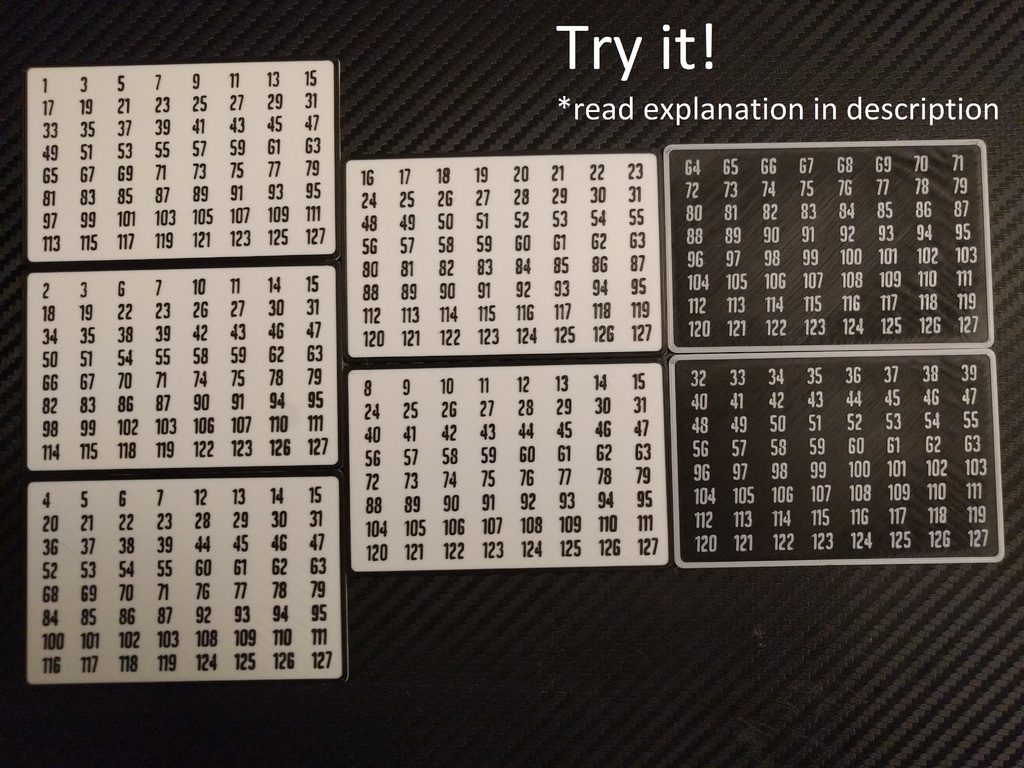
k014's parametric magic cards
thingiverse
This is a customizable set of cards that allows the owner to perform a simple yet astonishing magic trick. Here are the details: ## Example Routine * The magician asks the spectator to think of a number between 1 and N (N can be configured). * Once the spectator has done so, the magician hands all the cards to the spectator. * The magician then asks the spectator: "Please give me all the cards where your number appears." * Next, once the cards are separated, the magician asks for all the remaining cards. * Then, the magician quickly examines the cards and announces: "I see that the only number missing from the rest pile is X!" * The amazed spectator donates to the creator of this trick. ## Explanation Of course, the previous example routine is just an example, and the steps can be performed in any order or modified as desired. What's essential is not revealing the secret: ### Secret Each card has a number at the top left corner that must be summed against all cards where the number appears. For instance, if three cards have numbers [1, 4, 8] on them, and the spectator thought of the number 13, it would be calculated as 1 + 4 + 8 = 13. ### Why It Works If you understand binary numbers, each number can be represented by a string of zeros and ones. For example, the first four numbers in binary are: 0001 = 1 0010 = 2 0011 = 3 0100 = 4 As you can see, each number is a specific combination of 0's and 1's, similar to the decimal system, where each number is a combination of 10 digits (0-9). With this knowledge, a 0 can be represented as "not present" and 1 as "present," or in our case, "number not present on card" and "number present on card." This means that for example: 0101 = 5 You would be given only two cards: 0001 + 0100 = 0101 (5) Then, the sum of the corners 1+4=5, which is the number the spectator thought of. ## Algorithm I created a Python script to generate magical cards based on how many cards you want. In the STL provided with this design, I configured the script for 7 cards, but it will work with any number of cards. For example, if you select 2 cards, it will generate: [1, 3] [2, 3] Then, you can only guess numbers from 1 to 3. The spectator says his number appears in these cards: [1, 3] Result The number is 1, summing the corner numbers: 1 The spectator says his number appears in these cards: [2, 3] Result The number is 2, summing the corner numbers: 2 The spectator says his number appears in both cards: [1, 3] and [2, 3] Result The number is 3, summing the corner numbers: 1+2=3 There are no other possible combinations for the range 1 to 3. Simple, right? ## Try Before You Print! Check this image with all cards generated using 7 as input (then 7 cards generated):  * Think of a number between 1 and 127. * Sum the top left corner of each card where that number appears. * Voila! It has to be your number. ## Printing Recommendations * These cards were designed to be printable using multicolor G-codes. You don't need a multi-color printer; you just need to add a pause in the G-code to change filament color during print. I'm using "Color Print" from PrusaPrinters.org, but there are many tutorials on YouTube. * https://www.prusaprinters.org/color-print/ ## Download Links As always, all my designs are open-source. Since it's code, I don't want to push the code in Thingiverse because I want people to improve it and send me pull requests or if I make any changes, you'll always download the latest version. Here it is: https://github.com/joecabezas/python-magic-cards ### Dependencies: * https://github.com/SolidCode/SolidPython * Openscad
With this file you will be able to print k014's parametric magic cards with your 3D printer. Click on the button and save the file on your computer to work, edit or customize your design. You can also find more 3D designs for printers on k014's parametric magic cards.
